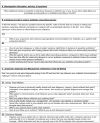Multisite exploration of clinical decision making for antibiotic use by emergency medicine providers using quantitative and qualitative methods
- PMID: 25111919
- PMCID: PMC4768482
- DOI: 10.1086/677637
Multisite exploration of clinical decision making for antibiotic use by emergency medicine providers using quantitative and qualitative methods
Abstract
Objectives: To explore current practices and decision making regarding antimicrobial prescribing among emergency department (ED) clinical providers.
Methods: We conducted a survey of ED providers recruited from 8 sites in 3 cities. Using purposeful sampling, we then recruited 21 providers for in-depth interviews. Additionally, we observed 10 patient-provider interactions at one of the ED sites. SAS 9.3 was used for descriptive and predictive statistics. Interviews were audio recorded, transcribed, and analyzed using a thematic, constructivist approach with consensus coding using NVivo 10.0. Field and interview notes collected during the observational study were aligned with themes identified through individual interviews.
Results: Of 150 survey respondents, 76% agreed or strongly agreed that antibiotics are overused in the ED, while half believed they personally did not overprescribe. Eighty-nine percent used a smartphone or tablet in the ED for antibiotic prescribing decisions. Several significant differences were found between attending and resident physicians. Interview analysis identified 42 codes aggregated into the following themes: (1) resource and environmental factors that affect care; (2) access to and quality of care received outside of the ED consult; (3) patient-provider relationships; (4) clinical inertia; and (5) local knowledge generation. The observational study revealed limited patient understanding of antibiotic use. Providers relied heavily upon diagnostics and provided limited education to patients. Most patients denied a priori expectations of being prescribed antibiotics.
Conclusions: Patient, provider, and healthcare system factors should be considered when designing interventions to improve antimicrobial stewardship in the ED setting.
Conflict of interest statement
Figures
References
-
- Lieberman JM. Appropriate antibiotic use and why it is important: the challenges of bacterial resistance. Pediatr Infect Dis J. 2003;22:1143–51. - PubMed
-
- Shlaes DM, Gerding DN, John JF, Jr, et al. Society for Healthcare Epidemiology of America and Infectious Diseases Society of America joint committee on the prevention of antimicrobial resistance: Guidelines for the prevention of antimicrobial resistance in hospitals. Clin Infect Dis. 1997;25(3):584–99. - PubMed
-
- Karras D. Antibiotic misuse in the emergency department. Acad Emerg Med. 2006;13(3):331–3. - PubMed
-
- Costelloe C, Metcalfe C, Lovering A, Mant D, Hay AD. Effect of antibiotic prescribing in primary care on antimicrobial resistance in individual patients: systematic review and meta-analysis. BMJ. 2010;340:c2096. - PubMed
Publication types
MeSH terms
Substances
Grants and funding
LinkOut - more resources
Full Text Sources
Other Literature Sources
Medical


